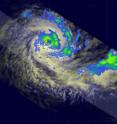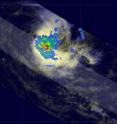Cyclone Anja hits wind shear, weakens drastically
This morning, Cyclone Anja was a powerful Category 4 cyclone on the Saffir-Simpson scale. Wind shear has now giving Anja a strong "punch in the gut" as the storm has weakened to a Category 1 cyclone. At 1500 UTC (10 a.m. ET) on November 17, Anja's maximum sustained winds were sustained at 75 knots (86 mph). Anja's center was located 715 miles east-northeast of La Reunion Island, near 18.3 South and 66.5 East. Anja is moving south-southwest at 12 mph. The storm seems to be spreading out as its weakening, as tropical storm force winds now extend out to 115 miles from the center (earlier today, they only extended 75 miles out from the center).
When tropical cyclone Anja formed on November 14, it was the first tropical cyclone in the southwestern Indian Ocean. That signaled the tapering off of northern hemisphere tropical cyclone activity and the start of tropical cyclone formation in the southern hemisphere. The Atlantic Ocean hurricane season officially ends at the end of November while the southwest Indian Ocean tropical cyclone season starts on November 1 and ends on April 30.
When the Tropical Rainfall Measuring Mission (TRMM) satellite passed over Anja on November 15 at 0904 UTC it had a well-defined eye and was increasing in strength from a category 2 tropical cyclone (on the Saffir-Simpson scale) to a powerful category 3 tropical cyclone later that day. TRMM is a joint mission between NASA and the Japanese space agency JAXA.
The TRMM satellite passed over Anja again on November 17 at 0850 UTC. The data from TRMM made it clear that upper level wind shear (winds blowing at different directions in the atmosphere that can tear a storm apart) had caused Anja to weaken greatly from its earlier maximum category 4 intensity. Anja no longer had a well defined eye but the TRMM derived rainfall analysis showed there was still very heavy rainfall in an area near Anja's center.
Anja is predicted to continue weakening and move harmlessly toward the southeast over the open waters of the south Indian Ocean.
Source: NASA/Goddard Space Flight Center
Articles on the same topic
- NASA's QuikScat and Aqua providing important data on Tropical Storm AnjaWed, 18 Nov 2009, 15:36:08 UTC
- NASA's Terra satellite spots Tropical Cyclone Anja, the first of the southern seasonMon, 16 Nov 2009, 21:15:21 UTC
Other sources
- QuikScat and Aqua providing important data on Tropical Storm Anjafrom PhysorgWed, 18 Nov 2009, 16:35:43 UTC
- Cyclone Anja hits wind shear, weakens drasticallyfrom Science BlogWed, 18 Nov 2009, 3:42:40 UTC
- Cyclone Anja hits wind shear, weakens drasticallyfrom Science BlogWed, 18 Nov 2009, 2:14:26 UTC
- Cyclone Anja hits wind shear, weakens drasticallyfrom PhysorgTue, 17 Nov 2009, 20:49:13 UTC
- Terra satellite spots Tropical Cyclone Anja, the first of the southern seasonfrom PhysorgMon, 16 Nov 2009, 21:14:08 UTC

